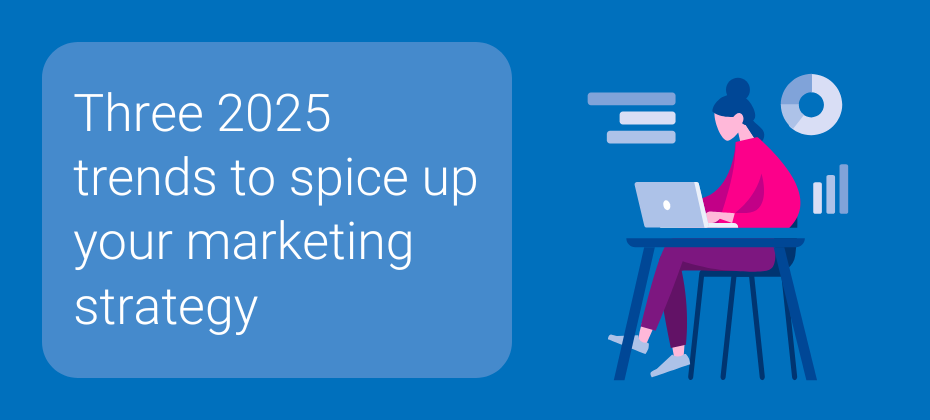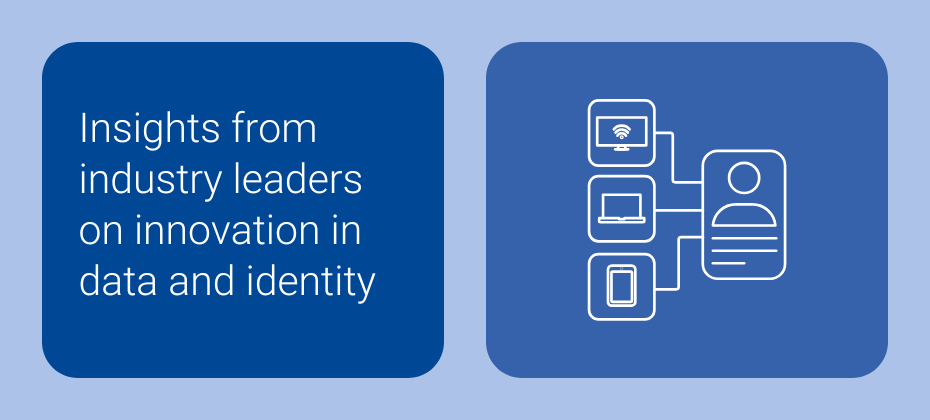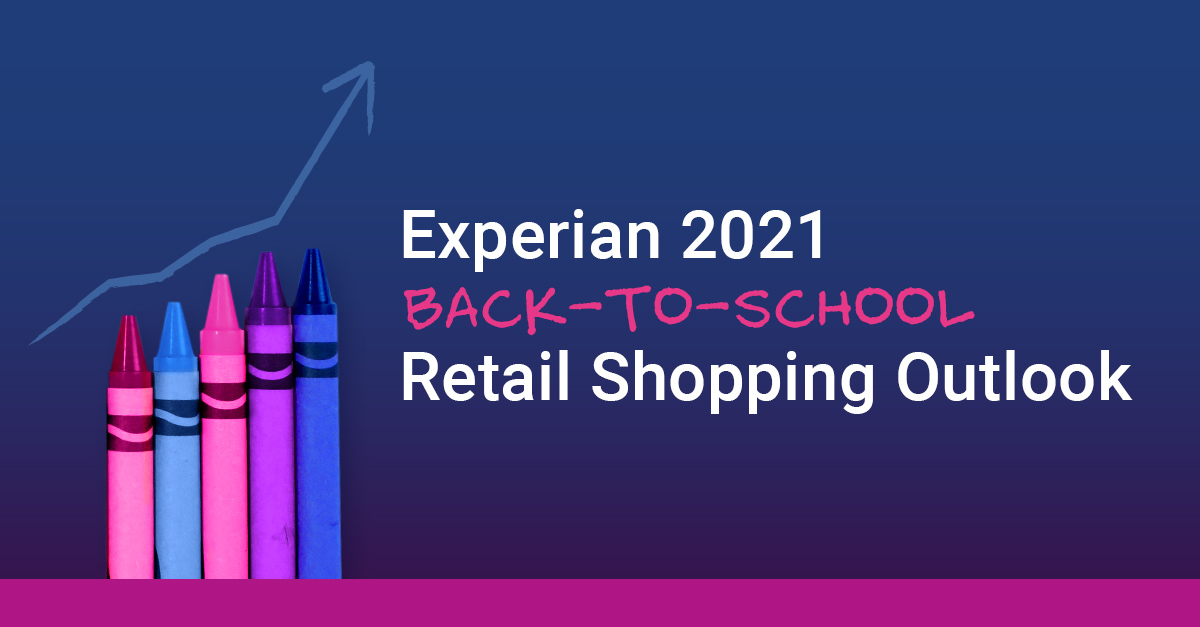Marketing across channels
The latest benchmarks and trends for executing effective, data-driven, cross-channel marketing strategies.

Agencies, platforms, and marketers stand at the crossroads of transformation, as privacy regulations tighten, technology accelerates, and consumer behaviors evolve. Yet these challenges also present extraordinary opportunities. Our 2025 Digital trends and predictions report highlights five trends that will shape 2025 and digs into: What’s changing in the market How to keep learning about your customers How to reach your customers in different places How to measure what’s really working along the way In this blog post, we’ll give you a sneak peek of three of these trends — from cracking the code of signal loss to tapping into the buzz around connected TV (CTV) and stepping up your omnichannel game. Think of it as a taste test before the main course. Ready for the full menu? Download our report to get the lowdown on all five trends. Download now 1. Signal loss: A rich appetizer of alternate ingredients As traditional cookies crumble, marketers need fresh ingredients to keep the flavor coming. Already, about 40% of browser traffic doesn’t support third-party cookies, and marketers are spicing things up with first-party data, alternative identifiers like Unified I.D. 2.0 (UID2) and ID5, and contextual targeting strategies. In fact, 50% more of our clients received alternative IDs (UID2, ID5, Hadron ID) in their Digital Graph in 2024 compared to 2023. The number of alternative IDs resolved to individuals in our Digital Graph increased by 30% year-over-year - as everyone looks beyond the cookie jar. There is no secret sauce to replace cookies. Instead, expect a multi-ID recipe that brings together different identifiers, unified by an identity graph. This approach turns a fragmented pantry of data into a cohesive meal, giving you a complete view of your customer on every plate. 2. The rising power of CTV: A hearty entrée of opportunities CTV is quickly becoming the main dish on the streaming menu, as viewers load up on their favorite shows. While CTV is slated to make up 20% of daily U.S. media consumption by 2026, advertisers are still holding back on pouring in the ad spend. To unlock its full flavor, marketers need to whip up solutions like frequency capping and unified audience activation. Although CTV will account for 20% of daily U.S. media consumption by 2026, it’s projected to command only 8.1% of ad spend. Frequency capping and unified audience activation solutions will be key to unlocking CTV’s full potential. By 2025, nearly half of CTV "diners" will choose free ad-supported streaming TV (FAST). Marketers need strategies to prevent ad overexposure. With 50% of U.S. consumers avoiding products due to ad overload, and 30% of marketers willing to increase their CTV spend if frequency capping improves, unified identity solutions help ensure every impression is served just right. 3. Omnichannel: A flavorful fusion plate No one likes a one-flavor meal. Marketers are moving beyond single-channel “side dishes” to omnichannel “fusion feasts” that blend direct mail, digital, CTV, and retail media networks (RMNs) into a truly cohesive culinary experience. Even though only 21% of global B2C professionals currently put omnichannel at the top of their shopping list, the growing demand for seamless, audience-first campaigns is heating up. In 2025, having an audience-first approach will be like having a perfect pairing for every course. Unified identity solutions act as your master sommelier, ensuring that each channel complements the next, and every customer enjoys a well-rounded, memorable journey. Vertical trends: A dessert sampler from four unique kitchens Different markets have their own signature flavors. In Auto, crossover utility vehicles (CUVs) claim 51% of new vehicle registrations, and consumers in the 35-54 age group and families are the primary buyers. Automotive marketers should prioritize CUV advertising with a strong focus on family-oriented and income-appropriate messaging In Financial Services, marketers need to anticipate shifts in consumer behavior tied to economic conditions, such as increasing demand for deposit products when interest rates are high. For insurance, aligning campaigns with life events, like new home purchases or marriage, can maximize engagement. In Healthcare, advertisers are prioritizing personalized, regulation-compliant campaigns that address social determinants of health (SDOH). In Retail, advertisers are increasingly activating on both CTV and social platforms, with many managing their own in-house campaigns. While larger brands often rely on media agencies, a shift toward in-house media buying is emerging among some bigger players, offering more control over audience targeting and performance metrics. Our report covers each vertical’s unique menu, helping you select the right “ingredients” for your customers. With the top Experian Audiences on hand, you can create feasts that delight, nourish, and convert. Hungry for more? Download our full menu The three “samples” you’ve just tasted are just the starters. Our 2025 Digital trends and predictions report serves up five insights, complete with strategies, data, and tools to help you adapt, scale, and thrive in 2025. Ready for the full menu? Download our report now and discover all five trends that will shape your marketing “cookbook” in 2025. Bon appétit! Download now Latest posts

Originally appeared on MarTech Series Marketing’s understanding of identity has evolved rapidly over the past decade, much like the shifting media landscape itself. From the early days of basic direct mail targeting to today's complex omnichannel environment, identity has become both more powerful and more fragmented. Each era has brought new tools, challenges, and opportunities, shaping how brands interact with their customers. We’ve moved from traditional media like mail, newspapers, and linear/network TV, to cable TV, the internet, mobile devices, and apps. Now, multiple streaming platforms dominate, creating a far more complex media landscape. As a result, understanding the customer journey and reaching consumers across these various touchpoints has become increasingly difficult. Managing frequency and ensuring effective communication across channels is now more challenging than ever. This development has led to a fragmented view of the consumer, making it harder for marketers to ensure that they are reaching the right audience at the right time while also avoiding oversaturation. Marketers must now navigate a fragmented customer journey across multiple channels, each with its own identity signals, to stitch together a cohesive view of the customer. Let’s break down this evolution, era by era, to understand how identity has progressed—and where it’s headed. 2010-2015: The rise of digital identity – Cookies and MAIDs Between 2010 and 2015, the digital era fundamentally changed how marketers approached identity. Mobile usage surged during this time, and programmatic advertising emerged as the dominant method for reaching consumers across the internet. The introduction of cookies and mobile advertising IDs (MAIDs) became the foundation for tracking users across the web and mobile apps. With these identifiers, marketers gained new capabilities to deliver targeted, personalized messages and drive efficiency through programmatic advertising. This era gave birth to powerful tools for targeting. Marketers could now follow users’ digital footprints, regardless of whether they were browsing on desktop or mobile. This leap in precision allowed brands to optimize spend and performance at scale, but it came with its limitations. Identity was still tied to specific browsers or devices, leaving gaps when users switched platforms. The fragmentation across different devices and the reliance on cookies and MAIDs meant that a seamless, unified view of the customer was still out of reach. 2015-2020: The age of walled gardens From 2015 to 2020, the identity landscape grew more complex with the rise of walled gardens. Platforms like Facebook, Google, and Amazon created closed ecosystems of first-party data, offering rich, self-declared insights about consumers. These platforms built massive advertising businesses on the strength of their user data, giving marketers unprecedented targeting precision within their environments. However, the rise of walled gardens also marked the start of new challenges. While these platforms provided detailed identity solutions within their walls, they didn’t communicate with one another. Marketers could target users with pinpoint accuracy inside Facebook or Google, but they couldn’t connect those identities across different ecosystems. This siloed approach to identity left marketers with an incomplete picture of the customer journey, and brands struggled to piece together a cohesive understanding of their audience across platforms. The promise of detailed targeting was tempered by the fragmentation of the landscape. Marketers were dealing with disparate identity solutions, making it difficult to track users as they moved between these closed environments and the open web. 2020-2025: The multi-ID landscape – CTV, retail media, signal loss, and privacy By 2020, the identity landscape had splintered further, with the rise of connected TV (CTV) and retail media adding even more complexity to the mix. Consumers now engaged with brands across an increasing number of channels—CTV, mobile, desktop, and even in-store—and each of these channels had its own identifiers and systems for tracking. Simultaneously, privacy regulations are tightening the rules around data collection and usage. This, coupled with the planned deprecation of third-party cookies and MAIDs has thrown marketers into a state of flux. The tools they had relied on for years were disappearing, and new solutions had yet to fully emerge. The multi-ID landscape was born, where brands had to navigate multiple identity systems across different platforms, devices, and environments. Retail media networks became another significant player in the identity game. As large retailers like Amazon and Walmart built their own advertising ecosystems, they added yet another layer of first-party data to the mix. While these platforms offer robust insights into consumer behavior, they also operate within their own walled gardens, further fragmenting the identity landscape. With cookies and MAIDs being phased out, the industry began to experiment with alternatives like first-party data, contextual targeting, and new universal identity solutions. The challenge and opportunity for marketers lies in unifying these fragmented identity signals to create a consistent and actionable view of the customer. 2025: The omnichannel imperative Looking ahead to 2025 and beyond, the identity landscape will continue to evolve, but the focus remains the same: activating and measuring across an increasingly fragmented and complex media environment. Consumers now expect seamless, personalized experiences across every channel—from CTV to digital to mobile—and marketers need to keep up. The future of identity lies in interoperability, scale, and availability. Marketers need solutions that can connect the dots across different platforms and devices, allowing them to follow their customers through every stage of the journey. Identity must be actionable in real-time, allowing for personalization and relevance across every touchpoint, so that media can be measurable and attributable. Brands that succeed in 2025 and beyond will be those that invest in scalable, omnichannel identity solutions. They’ll need to embrace privacy-friendly approaches like first-party data, while also ensuring their systems can adapt to an ever-changing landscape. Adapting to the future of identity The evolution of identity has been marked by increasing complexity, but also by growing opportunity. As marketers adapt to a world without third-party cookies and MAIDs, the need for unified identity solutions has never been more urgent. Brands that can navigate the multi-ID landscape will unlock new levels of efficiency and personalization, while those that fail to adapt risk falling behind. The path forward is clear: invest in identity solutions that bridge the gaps between devices, platforms, and channels, providing a full view of the customer. The future of marketing belongs to those who can manage identity in a fragmented world—and those who can’t will struggle to stay relevant. Explore our identity solutions Latest posts

Consumers engage with content and advertisements across various devices and platforms, making an identity framework essential for establishing effective connections. An identity framework allows businesses to identify consumers across multiple touchpoints, including the relationships among households, individuals, and their devices. Combined with a robust data framework, businesses can understand the relationship between households, individuals, and marketing attributes. Consequently, businesses can tailor and deliver personalized experiences based on individual preferences, ensuring seamless consumer interactions across their devices. We spoke with industry leaders from Audigent, Choreograph, Goodway Group, MiQ, Snowflake, and others to gather insights on how innovations in data and identity are creating stronger consumer connections. Here are five key considerations for advertisers. 1. Embrace a multi-ID strategy Relying on a single identity solution limits reach and adaptability. Recent data shows that both marketers and agencies are adopting multiple identity solutions. By embracing a multi-ID strategy with solutions like Unified I.D. 2.0 (UID2) and ID5, brands can build a resilient audience targeting and measurement foundation, ensuring campaigns remain effective as identity options evolve across channels. A diversified identity approach ensures that advertisers are not left vulnerable to shifts in technology or policy. By utilizing multiple ID solutions, brands can maintain consistent reach and engagement across various platforms and devices, maximizing their campaign effectiveness. "I don't think it will ever be about finding that one winner...it's going to be about finding the strengths and weaknesses and what solutions drive the best results for us."Stephani Estes, GroupM 2. Utilize AI and machine learning to enhance identity graphs Identity graphs help marketers understand the connections between households, individuals, their identifiers, and devices. This understanding of customer identity ensures accurate targeting and measurement over time. AI and machine learning have become essential in making accurate inferences from less precise signals. These technologies strengthen the accuracy of probabilistic matches, allowing brands to understand consumer behavior more effectively even when data fidelity is lower. Adopting a signal-agnostic approach and utilizing various ID providers enhances the ability to view consumers' movements across platforms. This strategy moves measurement beyond isolated channels, providing a holistic understanding of campaign effectiveness and how different formats contribute to overall performance. By integrating AI and machine learning into identity graphs, advertisers can develop more cohesive and effective marketing strategies that guide customers seamlessly through their buying journey. "What we're finding is more and more identity providers are using Gen AI to locate connections of devices to an individual or household that maybe an identity graph would not identify."David Wells, Snowflake 3. Balance privacy with precision using AI AI-driven probabilistic targeting and identity mapping provide effective solutions for privacy-focused advertising. Rather than relying on extensive personal data like cookies, AI can use limited, non-specific information to predict audience preferences accurately. This approach allows advertisers to reach their target audience while respecting privacy—a crucial balance as the industry shifts away from traditional tracking methods. According to eMarketer, generative AI can further enhance audience segmentation through clustering algorithms and natural language processing. These tools enable more granular, privacy-compliant targeting, offering advertisers a pathway to reach audiences effectively without needing third-party cookies. "I think the biggest opportunity for machine learning and AI is increasing the strength and accuracy of probabilistic matches. This allows us to preserve privacy by building models based on the features and patterns of the consumers we do know, instead of transmitting data across the ecosystem."Brian DeCicco, Choreograph 4. Activate real-time data for better engagement Real-time data enrichment introduces dynamic audience insights into the bidding process, enabling advertisers to respond instantly to user actions and preferences. This agility empowers marketers to craft more relevant and impactful moments within each campaign. "Real-time data enrichment--where data companies can have a real-time conversation with the bid stream--is an exciting part of the future, and I believe it will open the door to activating a wide variety of data sets."Drew Stein, Audigent 5. Create and deploy dynamic personas using AI Generative AI transforms persona-building by providing advertisers with richer audience profiles for more precise targeting. This approach moves beyond traditional demographic categories, allowing for messaging that connects more meaningfully with each consumer. By using generative AI to craft detailed personas, advertisers can move beyond generic messaging to create content that truly resonates on an individual level. This personalized approach captures attention and strengthens consumer relationships by addressing their specific needs and interests. "One cool thing we've built recently is a Gen AI-based personas product that generates personas to create highly sophisticated targeting tactics for campaigns."Georgiana Haig, MiQ Seize the future of data-driven engagement Focusing on these five key innovations in data and identity allows you to adapt to the evolving media landscape and deliver personalized experiences to your audience. Connect with our experts Latest posts

With U.S. brands expected to invest over $28 billion in connected TV (CTV) in 2024, balancing linear TV and CTV is now a top priority. Advertisers need to integrate these platforms as the TV landscape evolves to reach audiences with various viewing habits. A successful strategy requires both linear and CTV approaches to effectively reach audiences at scale. We interviewed experts from Comcast Advertising, Disney, Fox, Samsung Ads, Snowflake, and others to gain insights on the evolving landscape of linear and CTV. In our video, they discuss audience fragmentation, data-driven targeting, measurement challenges, and more. Watch now to hear their perspectives. Five considerations for connecting with linear TV and CTV audiences 1. Adapt to audience fragmentation With consumers' rapid shift toward streaming, it's easy to overlook the enduring significance of linear TV, which still commands a large portion of viewership. According to Jamie Power of the Walt Disney Company, roughly half of the current ad supply remains linear, highlighting the need for brands to adapt their strategies to target traditional TV viewers and cord-cutters. As streaming continues to rise, ensuring your strategy integrates both CTV and linear TV is crucial for reaching the full spectrum of audiences. "I don't think that we thought the world would shift so quickly to streaming, but it's not always just all about streaming; there's still such a massive audience in linear."jamie power, disney 2. Combine linear TV’s reach with CTV’s precision Blending the reach of linear TV with the granular targeting capabilities of CTV allows advertisers to engage both broad and niche audiences. Data is critical in understanding audience behavior across these platforms, enabling brands to create highly relevant campaigns tailored to specific audience segments. This strategic use of data enhances engagement and ensures that the right viewers see advertising campaigns. "The future of TV is really around managing the fragmentation of audiences and making sure that you can reach those audiences addressably wherever they're watching TV."carmela fournier, comcast Advertising 3. Manage frequency across platforms Cross-platform campaigns require managing ad frequency to avoid oversaturation while ensuring adequate exposure. With a variety of offline and digital IDs resolved to consumers, our Digital and Offline Graphs can help maintain consistent messaging across linear TV and CTV. This approach allows advertisers to strike the right balance, preventing ad fatigue and delivering the right audience reach for campaign impact. "You've got to make sure that you're not reaching the same homes too many times, that you're reaching everybody the right amount of times."justin rosen, ampersand 4. Focus on consistent measurement Linear TV and CTV offer different data granularities, necessitating tailored approaches for accurate cross-platform campaign measurement. Bridging these data gaps requires advanced tools that streamline reporting for both mediums. As the industry moves toward consistent measurement standards, advertisers must adopt solutions that provide a comprehensive view of campaign performance, enabling them to optimize their cross-platform efforts. "Where I think there are pitfalls are with the measurement piece, it's highly fragmented, there's more work to be done, we're not necessarily unified in terms of a consistent approach to measurement."april weeks, basis 5. Align with shifts in audience behavior The success of cross-platform campaigns hinges on staying agile and responsive to shifting audience preferences. As CTV adoption grows, advertisers must proactively adjust their strategies to align with how viewers engage across linear and streaming platforms. Ideas include: Regularly updating creative Adjusting the media mix Utilizing real-time data insights to ensure campaigns remain relevant "At Fox we were a traditional linear company, and essentially what we're trying to do is merge the reach and the scale of TV as well as the reach and the scale of all the cord-cutters and cord-nevers that Tubi possesses." Darren Sherriff - Foxdarren sherriff, fox As streaming TV rapidly changes, brands must stay ahead of trends and shifts in consumer behavior to tap into CTV's growing potential. By focusing on these opportunities, advertisers can blend linear TV and CTV, ensuring their campaigns reach audiences wherever they watch. Connect with Experian's TV experts As a trusted leader in data and identity services, Experian offers the expertise to help you succeed in television marketing. With our strong partnerships with key players in the TV industry, we provide access to unique marketing opportunities. Learn how Experian’s data and identity solutions can deliver outstanding results in advanced TV advertising. Partner with us today to enhance your marketing strategies using our Consumer View and Consumer Sync solutions. Connect with our TV experts Latest posts

With the impending deprecation of third-party cookies, marketers find themselves at the crossroads of innovation and adaptation. As we bid farewell to this identifier, the emphasis shifts to forging deeper connections, understanding customer needs, and navigating the marketing landscape with data-driven precision. At Experian, we stand as your trusted partner, committed to guiding you through this transition. In this blog post, we'll explore: How third-party cookie deprecation is impacting digital advertising Six alternatives to third-party cookies and where they fall short How Experian can help you navigate a cookieless world Four ways third-party cookie deprecation is impacting digital advertising Third-party cookie deprecation is causing significant challenges within the AdTech industry, manifesting in four key areas: Reach: Advertisers and demand-side platforms (DSPs) will face difficulties in reaching their target customers due to the absence of third-party cookies. Understanding audiences: Advertisers will find it challenging to understand the demographics and behaviors of their customer base without third-party cookies. Similarly, publishers are struggling to identify their audiences accurately, resulting in less addressable and appealing inventory. Measurement: Measurement providers may encounter obstacles in accurately assessing the effectiveness of advertising campaigns. Additionally, DSPs are finding it hard to measure the impact of their ads without the assistance of third-party cookies. Matching: Data providers may experience challenges in matching users with the appropriate audience segments, leading to difficulties in delivering targeted advertising. Six alternatives to third-party cookies As the deadline approaches for Google's removal of third-party cookies from Chrome by the end of 2024, marketers are scrambling to discover alternative methods for delivering effective advertising. Fortunately, various alternatives are emerging. However, the abundance of options can create confusion rather than clarity. Which alternatives are worth considering? Here are six compelling alternatives to third-party cookies: 1. First-party data Acquiring consented first-party data directly from users is becoming increasingly vital as it can lay the groundwork for more precise targeting. 2. Universal IDs Alternative identifiers like The Trade Desk's UID2 and ID5’s Universal ID are becoming increasingly important, offering the ability to maintain a comprehensive consumer view across channels and platforms, leading to enhanced personalization and addressability across various channels, even in cookieless environments. 3. Identity graphs As browser-based IDs shift and digital signals decline, the need for an identity graph grows, with companies adopting a "graph-of-graph" strategy by combining their own robust first-party data with licensed identity graphs, as highlighted in recent announcements by industry giants such as Disney, VideoAmp, and Magnite. 4. Contextual targeting Contextual targeting aligns publisher content with relevant ads, ensuring ad delivery based on content rather than individual identifiers. This privacy-respecting approach is less dependent on third-party cookies, providing effective audience activation. 5. Data collaboration In a cookieless world, it becomes more difficult for companies to "communicate" with one another. We expect to see more pick up of data collaboration in the market, using addressable IDs and identity resolution to power connectivity between partners and their data sets. 6. Google Privacy Sandbox The primary goal of Google’s Privacy Sandbox is to continue to deliver valuable consumer information that yields relevant marketing and media strategies, while protecting a user’s privacy. How these alternatives to cookies fall short While it's promising to see numerous alternatives to cookies emerging, it's essential to recognize that each alternative has its limitations and is not a perfect one-to-one replacement for third-party cookies. Let’s review the shortcomings of these alternatives, and then we’ll walk through how Experian can help you navigate these alternatives to cookies. 1. First-party data First-party data, which is data directly collected from your users with their consent, is highly valuable. However, you will likely face limitations in terms of the number of consumers in your database, the identifiers linking them, and the insights into their demographics and behaviors. To overcome these limitations, it's essential to expand both the quantity and quality of your first-party data. 2. Universal IDs Universal identifiers are valuable for tracking users across different devices and websites. However, no single universal identifier has enough reach to fully replace third-party cookies. Universal IDs are most effective in terms of scaling, when they are combined with other universal identifiers or alternative addressable identifiers. 3. Identity graph Identity graphs excel at connecting digital audiences. However, establishing an identity graph from scratch is a significant accomplishment, demanding expertise, financial resources, and more. 4. Contextual targeting Contextual targeting and advertising aim to place your ads next to relevant content. However, there's a risk that your ads might appear alongside misaligned content, reaching audiences who are uninterested or unintended. 5. Data collaboration Data collaboration is beneficial for enhancing your consumer data and informing your strategies. However, it can introduce potential data security risks, if not done in the right framework, and may lead to subpar matching results due to issues like data hygiene or discrepancies in identifiers. 6. Google Privacy Sandbox Google’s Privacy Sandbox aims to balance effective advertising with consumer privacy and data security. However, it lacks transparency and has yet to prove its effectiveness, raising concerns about whether it meets industry standards. How Experian can help you navigate a cookieless world As an industry innovator and leader in data and identity, we've developed solutions to address the challenges posed by the shift away from third-party cookies. Our products are designed to adapt to these changes and ensure your success. We've anticipated industry shifts and proactively prepared our offerings to support you through this transition. Below we outline how our products are ready to support you through the transition away from third-party cookies. Graph The Experian Graph facilitates connectivity without relying on cookies. Our Graph helps ensure connectivity by supporting a variety of addressable identifiers, not limited to but including universal IDs, like Unified ID 2.0 (UID2) and ID5's universal ID. Whether you have first-party data or not, our Graph can be used to expand the reach of your first-party data or provide you with access to the full scope of our Graph's 126 million households and 250 million individuals. Activity Feed Supported by our Graph, Activity Feed can help you deliver digital connectivity and resolution in a cookieless environment. Activity Feed can resolve disparate activity to a single, consumer profile. It can expand the quantity of addressable identifiers associated with your first-party consumers. Additionally, Activity Feed, by joining disparate activity and identifiers, provides clearer insights, more addressable targets, and more holistic measurement. Our Marketing Attributes and Audiences In a cookieless environment, our Marketing Attributes and Audiences provide valuable information and insights about who your consumers are, like their demographics, shopping patterns, and more, to facilitate more informed decision-making. You can use our Marketing Attributes and Audiences to enrich your first-party data, giving you crucial insights into your customers so you can make informed, strategic decisions. They can be matched to universal identifiers, expanding their utility. Additionally, our Marketing Attributes and Audiences are sourced from non-cookie dependent offline and digital sources, ensuring they are unimpacted by third-party cookie deprecation. Collaboration While third-party cookies have primarily served to connect data in the industry, many companies are turning to data collaboration in lieu of having third-party cookies. In doing so, they can connect data with key partners, which they can use to make better media decisions. Experian Collaboration helps make data collaborations better, powering higher match rates by using the various identifiers supported in our offline and digital graphs. Through our current support of collaboration in three environments, within Experian, through crosswalks, and in clean rooms, such as AWS, InfoSum, and Snowflake, we ensure that you only share the data you intend to share, while the sensitive information remains secure. This way, your partner and you can focus on how to use the data to benefit you and not on anything else. Get started with alternatives to third-party cookies today While many view the deprecation of third-party cookies as disruptive, we see it as an opportunity for the industry to embrace a new era of advertising while prioritizing consumer privacy. Achieving this balance is crucial, and Experian's solutions are here to help you navigate it effectively. As the AdTech industry gravitates toward a few tactics to effectively advertise in the cookieless future, Experian is here to understand your core needs and recommend products that will help. In a rapidly evolving marketing landscape, Experian stands as your trusted partner, offering expertise in data-driven and identity solutions. Connect with our team to seamlessly transition into these alternatives to third-party cookies, ensuring your marketing strategies remain effective, privacy-compliant, and focused on meaningful connections. Get started today Latest posts

Industry leaders recently gathered at the influential Beet Retreat 2023 conference held in Santa Monica, sharing forward-looking perspectives on the future of advertising. This renowned event known for its diverse mix of leaders from TV, agencies, advertising, and technology sectors, was enriched by insights from Experian’s very own Chris Feo, SVP of Sales & Partnerships, and Kimberly Gilberti, Chief Product Officer. Both Feo and Gilberti brought their expertise and perspectives for harnessing the potential of high-growth connected TV (CTV) advertising. The era of connected everything at Beet Retreat 2023 In the “Era of Connected Everything,” panel, Feo dived into the concept of a ‘connected everything’ world. He emphasized the importance of balancing consumer and privacy expectations with the increasing integration of AI and machine learning. “As decisioning evolves, creative tech and data derived from creative scale will play a bigger role.”chris feo, svp, sales & partnerships Feo further discussed the potential of creative technology, particularly in how AI and machine learning could revolutionize content personalization. He cited examples where the same creative content is used indiscriminately across diverse demographics, suggesting a future where creative content adapts and performs well for a variety of audience identities. Experian's balanced approach at Beet Retreat 2023 During a fireside chat, Gilberti shared her vision on the transformative role of television in the advertising technology landscape. “Connecting exposure to business outcomes is the holy grail of measuring CTV and effectiveness.”kimberly gilberti, chief product officer Her insights reflected the growing interplay between digital and traditional TV advertising, and the opportunities arising from this convergence. Gilberti emphasized the critical role of data analytics in enabling advertisers to tailor content more effectively to diverse TV audiences. She envisioned a future where the integration of digital strategies and traditional TV advertising create a more cohesive and impactful AdTech approach. Future focus: Diversification and partnerships Both Feo and Gilberti underscored the need for advertisers to diversify their partnerships. By working with a variety of partners, you can mitigate risks and foster innovation, ensuring you are not overly dependent on a single channel or approach. Navigate what’s next with Experian Experian's contributions at Beat Retreat 2023 underscore our pivotal role in the AdTech industry. With a unique balance of offline and online data expertise, we are not just adapting to changes but leading the way in innovation and strategy. Our insights and approaches, as highlighted by Feo and Gilberti, demonstrate our commitment to guiding the industry through its rapid evolution, making our role indispensable in the future of advertising technology. At Experian, we’re your partner in data-driven marketing and can help make your interactions more meaningful. To learn more, connect with a member of our team today. Connect with us Latest posts

The holiday season is just around the corner, and retailers and marketers are gearing up for the busiest shopping period of the year. It's crucial to understand how consumer behavior is evolving and what emerging trends to expect. Experian's 2023 Holiday spending trends and insights report analyzes recent trends, consumer spending habits, and anticipates what's to come in 2023 to help you deliver a top-notch shopping experience this holiday season. In this blog post, we'll cover three key insights from our report. 1. Consumers are shopping earlier It's no secret that December has always been the go-to month for consumers when it comes to holiday spending. However, holiday shopping now starts earlier, particularly with online sales. This can be attributed to a surge in promotions and deals, enticing shoppers to open their wallets ahead of time, giving a significant boost to holiday sales. Notably, Cyber Week sales have proven to be an influential factor, accounting for 8% of total consumer holiday spending. Experian tip Reach the right shoppers with your promotions with sell-side targeting. This powerful approach gives you control over where your ads are placed while ensuring maximum visibility through direct connections with publishers. Whether on mobile, web, or CTV, this seamless ad experience will engage your audience effectively. 2. Online sales are on the rise The popularity of online holiday sales is continuously growing, surpassing in-store shopping. There has been a consistent 1% year-over-year increase in online sales, while in-store sales have seen a 1% decrease. "It’s easier for consumers to comparison shop for large ticket items online that they might find at a mass retailer or office supply store. Consumers prefer to have larger, bulkier items shipped directly to their home for minimal cost. By shopping online, consumers can save time since they don’t need to wait in checkout lines." Anna Liparoto, Sr. Account Executive, Retail & CPG Although online sales currently make up only one-third of all holiday shopping, there is immense potential for further expansion. Mass retailers and office, electronics, and games industries particularly excel in online holiday sales. While in-store purchases remain the primary choice for holiday shoppers, consumer online and offline activities intersect before the final purchase. Experian tip Take advantage of the surge in online shopping by diversifying your marketing channels. An agnostic identity graph can bring together device and media data, capturing valuable user insights. By gaining a holistic view of your target audience, you'll be able to optimize your ad spend and allocate resources effectively, ultimately boosting your return on investment. "Omnichannel targeting during the upcoming holiday season will continue to prove to be the best way to reach scale and maximize ROI across all marketing channels."Joe LigÉ, Head of Enterprise Demand Partnerships 3. 2023 holiday spending will be on par with 2022 During the holiday season in 2022, consumer spending showed an anticipated increase, although the growth rate was slightly lower compared to previous years. October saw a surge in average consumer spending, indicating a swift response to early discounts and promotions offered by retailers. As the holiday season progressed, holiday spending gradually slowed down and reached a level similar to that of the previous year. Overall, there was a modest 2% growth. Looking into the future, if economic conditions remain stable in the second half of 2023, we can expect holiday spending to align with the figures from last year. Experian tip To truly maximize impact, consider data enrichment. By diving deeper into your target audience's preferences and behaviors, you can better tailor your strategies and seamlessly integrate the enriched data across various channels. This allows you to unlock the true potential of your ad inventory, creating more meaningful connections with your audience. Download our 2024 report Get ready for the holiday shopping season with Experian's 2024 Holiday spending trends and insights report. Inside you'll find: Analysis of past trends and what they mean for 2024 Exclusive predictions for the upcoming holiday season The top audiences to activate this holiday season To access to all of our predictions for this year's holiday shopping season, download our 2024 Holiday spending trends and insights report today. Download now Latest posts

Experian kicks off the AdTech year at CES What better way to jump-start start 2023 than a trip to Las Vegas for the Consumer Electronics Show (CES). Our team was thrilled to participate in this annual kick-off with the AdTech community. The uniqueness of what CES has become for our industry can be defined as the intersection between technology brands, digital, television, and AdTech. CES creates the space necessary for marketing and advertising leaders to collaborate to drive rewarding outcomes for the year ahead. Our goal in attending CES was to connect with our partners, clients, and industry leaders to build relationships, form strategic plans, and listen. The opportunity to learn about our industry’s challenges and goals enables us to develop initiatives, drive success, and support our clients and partners. Keep reading for our 2023 CES AdTech recap. “I have been to CES too many times to mention the number; this year was as energetic, collaborative, engaged, and effective as I can ever recall. Our presence was first-class and meticulously organized, which made our interactions as robust as possible. It's a team effort, and we appreciate all the work that goes into this event. “ - Greg Koerner, Vice President of Digital Advertising Sales Our CES AdTech recap Supporting publishers and advertisers is top of mind for us. Many of our conversations focused on the technologies we deliver or collaborate with our partners to provide. Clean rooms and activation were two common themes throughout our discussions. Clean rooms Consumer privacy, regulatory requirements, and data deprecation are driving the AdTech industry to talk about and explore clean rooms. There’s a need to address data collection, storage, analysis, and sharing. Clean rooms are a potential solution that can standardize data and address interoperability issues. Activation In 2023, we predict that digital activation will increase. We continue to see increased demand for environments where alternative identifiers are being transacted (like demand side platforms and video). Social platforms will continue to experience volatility and advertisers will shift their focus to demand-side, video, and supply-side platforms. Download our 2023 Digital audience trends and predictions report to learn where you should activate your audiences in 2023. We can help plan your 2023 digital activation strategy. How we support clean rooms and activation Our Consumer Sync and Consumer View products support these areas and can help you understand people better--so you and your customers can connect with confidence. What is Consumer Sync? Consumer Sync, our consumer identity product, enables signal agnostic collaboration across marketers and technologies, bringing together digital devices, IDs, households, and attributes. Consumer Sync’s Resolution and Collaboration solutions can help you gain a better understanding of your consumers and make identities actionable in any environment. What is Consumer View? Consumer View, our data discovery product, offers marketers a robust, privacy-first understanding of their customers and prospects. Grounded in consumer identity, Consumer View provides the data foundation to engage consumers where, when, and how they want. Consumer View’s Audience and Attribution solutions provide expansive coverage so that you can fill in the gaps to better understand your prospects. Additionally, our collaborative efforts with strong partnerships across the clean room ecosystem and with our activation partners help our clients serve the best ads, at the best times, to the right audience. “CES is back and was a great way to kick off the new year! We were able to meet with a high volume of clients to eagerly talk about building new solutions for the TV space. We are excited to see where these conversations lead in the next few months.” - Ali Mack, Senior Director of TV Advertising Sales Let’s navigate what’s new in our industry, together We can help you connect with your consumers in innovative, impactful ways. Contact us to continue the conversation and learn more about our Consumer Sync and Consumer View products. We can help you take advantage of the opportunities on the horizon.

As kids are packing their new backpacks and heading back to school, search trends and online behavior give insights about the things students (and their parents) care about this year.